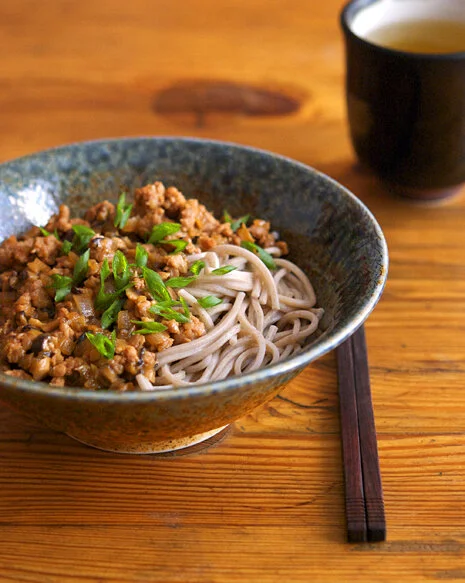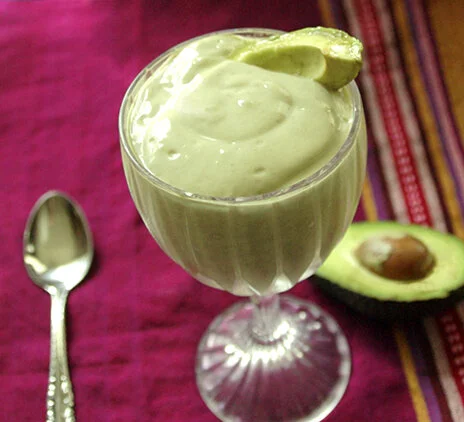This dish of minced pork ladled over soba is comfort food at its best.
Read MoreAs much as I love to cook, I never have time to plan weekday lunches. After a frazzled morning at the desk, trying to get just one more bit of work done, I am ravenous by 1 or 2pm. My lame attempts at breakfast (usually Wheatables and fruit gummies) do not suffice.
I storm out of the building in a mad search for anything edible on the street. Unfortunately, other than mediocre $10 sandwiches and faux-Mexican, there is nothing except Safeway and Whole Foods. So I go for supermarket soup. Soup is filling. Soup is warming. Soup is cheap (well, not at Whole Foods). But sooner or later, you get sick of Chunky Chicken Noodle and Spicy Southwestern Bean. I still craved a piping hot bowl of broth-and-protein in the early afternoon, but needed a change.
This week I decided to add a Chinese take-out touch to chicken noodle soup. And make a big batch on Sunday night. While I still like the hot and sour soup I posted two year ago, this one is much, much more filling. And if you are low on Asian pantry staples like canned bamboo shoots and lily buds, you can still make this. I went to the market and bought chicken breast, mushrooms, and scallions, et voilà.
Read MoreIt took a trip to Japan to realize I've been making edamame wrong all these years.
Well, not necessarily wrong wrong. But not the best way possible.
When I discovered the joys of edamame about 10 or 12 years ago, I would buy bags of the frozen stuff, microwave them, and sprinkle table salt on top. Then I progressed to boiling them in a pot. When I discovered fresh edamame in Chinatown, and replaced Morton with Malden, I thought this was as good as edamame could get. After all, it tasted the same as at all the Japanese restaurants in the US.
Then I went to Japan. In Tokyo this past summer, I noticed something slightly different about the fuzzy little legume that was as good an accompaniment with omikase-style sushi as it was with beer at 2 a.m. My meals of tempura, sashimi, fugu, and yes, even fugu sashimi were all bookended by a dish of edamame that tasted, well, better. Was it just because my subconscious dictated that the Japanese food had to taste better in Japan?
Read MoreIf a fruit grows in abundance in Vietnam, you can be sure it is pulsed into a shake. And avocados are everywhere.
Read MoreRecently, while visiting Jacob's grandmother in California, I discovered a torn cookbook in her kitchen drawers. "Oh!" she exclaimed. "You found my bible!"
Titled "Country Cookin'", the book was published in the 1970s by the Monterey County Cowbelles, otherwise known as the wives of Monterey's ranchers. Surprisingly, only a tenth of the book is devoted to red-meat-centric dishes. Most of the recipes are charmingly anachronistic, like Dove in Wine Sauce and Hot Russian Tea (with Tang!). But what really caught my attention were the handful of Chinese recipes.
Read MoreThis is the older version of the Chinese Scallion Pancakes recipe using yeast that was first published in 2009. For the newer version without yeast, see Chinese Scallion Pancakes.
Read MoreI love owning a bamboo steamer, if for no other reason that to display around the kitchen. It's not only a conversation starter whenever new guests visit but also a handy tool for food photography. (Gotta play up the Asian theme sometimes.) Plus, a set of basket and lid usually costs less than $10 in Chinatown.
Of course, there are times when bamboo steamers are useful for actual cooking. Aside from har gow, shumai is possibly the most requested dim sum standard in my family, with the reliable crinkly yellow wonton wrappers snugly encasing the pork-dominant filling. I haven't tackled har gow at home yet, possibly because even 95% of all restaurants I visit fail at the texture of the translucent wrapper. But siu mai I can do.
Read MoreUntil the age of 6, I had never eaten raw unpickled cucumbers. Like everyone else in my Cantonese family, I ate cucumbers only in stir-fries, never imagining that they could be served any other way. So it was a shock in the elementary school cafeteria to find that Americans eat this thing called a salad, with itty bitty pieces of raw unseasoned cucumber, mixed with equally bland raw carrots and iceberg lettuce. I'll admit. It took me a few years to get used to raw cucumbers, especially when the accompaniment was Thousand Island dressing.
Lately I've rediscovered the joys of stir-fried cucumbers. They're sauce sponges, soaking up the best flavors of whatever meat or liquid they're cooked with. The best kind to use for stir-frying are Chinese cucumbers, also called Asian or Peking cucumbers, the long skinny ones with a bumpy outside. They tend to be more crisp, though other varieties would also work.
Read MoreI became addicted to adobo while living in Brooklyn. Albert, my roommate from Guam, made chicken adobo one night and handed me a plate with some fat chicken thighs, a thick brown sauce with onions, and a clump of rice. Keep in mind that at this time, I was making dainty hors d'oeuvres everyday in culinary school and hadn't eaten good home-cooked braised meat in months. One bite and I was in heaven.
"What's in this?" I asked.
"Soy sauce, vinegear, honey, pepper."
"No, there's something else," I insisted.
He whipped out a small spice bottle. Mrs. Dash Original Blend. Just what his mom used to use.
Read MoreOne of the reasons I love visiting my parents in Zhongshan in Guangdong province is indulging in all the Cantonese food I miss living up north. And rarely do we eat out, although not for lack of good restaurants. Mostly we cook at home, sometimes experimenting, other times cooking old favorites.
Clay pot rice with Cantonese sausage is one of my favorite homestyle favorites. Why eat plain rice when you can gobble up rice flavored with juicy sausages? Called "lap mei fan" or "bo zai fan" in Cantonese, clay pot rice is one of the easiest ways to elevate a weeknight meal, or act as a stand-alone meal.
What kind of sausage can you use? Either of the ones in the photo below: all-pork sausage (the reddish one, and most common kind), or pork and duck (the darker ones, smokier in flavor.) The squarish piece is cured duck meat, like cured ham except different animal. The most common "lap mei fan" includes all three, but you can use just the all-pork sausage, which is easiest to find outside China.
Read More

